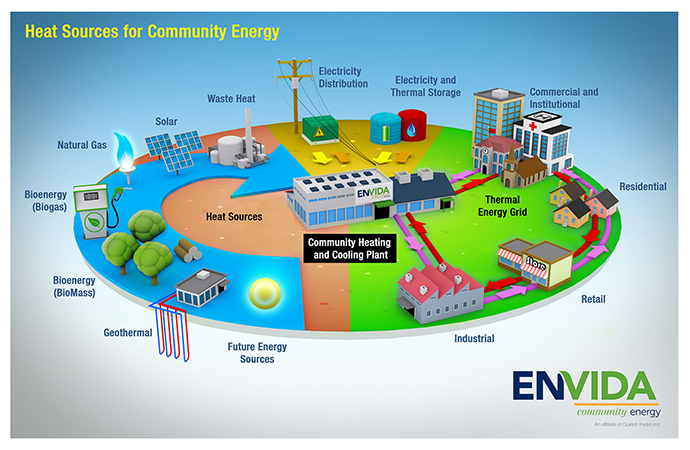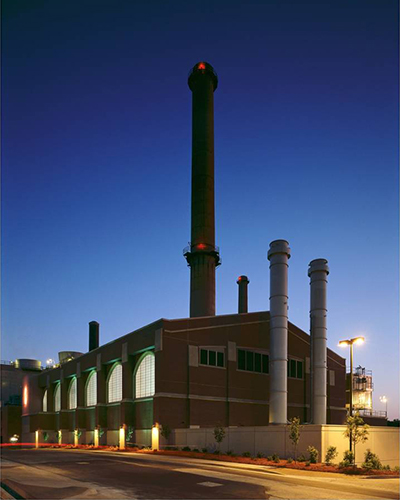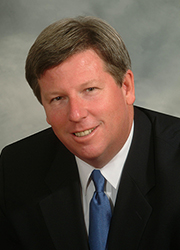In November, the International District Energy Association (IDEA) released a new planning guide for community energy, or thermal networks, customized for the Canadian market. In Guelph, Ont., about an hour west of Toronto, they’re already living it.
Guelph is the first community in North America to establish and announce a plan for an interconnected thermal grid to serve industrial, commercial and residential buildings across an entire city. Its District Energy Strategic Plan is part of a larger, award-winning Community Energy Initiative.
A highlight of that grid is the Sleeman Centre, the city’s arena downtown, where a system owned and operated by Envida Community Energy Inc., a subsidiary of Guelph Hydro Inc., will serve as the central heating and cooling plant for the Galt District Energy System.
Buildings connected to a district energy system save money because they don’t need individual furnaces, boilers, air conditioning units, or cooling towers. District energy allows multiple buildings to share a super-efficient heating and cooling system. A central network of underground pipes moves steam, hot or cold water to provide space heating, water heating, air conditioning, and, in some cases, electrical power for the buildings connected to the system. As the city’s plan explains, benefits include:
- more predictable long-term operating costs
- dependable, reliable thermal energy
- reduced greenhouse gas emissions
- reduced space requirements
- reduced fuel and maintenance costs, and avoiding capital costs.
“The Galt District Energy System is an excellent example of how we are doing more with less — in this case, providing cost-competitive, and clean heating and cooling while consuming less energy,” said Guelph Mayor Karen Farbridge. “In addition to the financial and environmental benefits, this project supports the local economy and creates local jobs. It also improves Guelph’s energy security by reducing our reliance on the provincial transmission grid.”
A subset of district energy more familiar to corporate end users is combined heat and power (CHP), which many industrial companies in particular have looked to in recent years. At a large-scale power plant, up to 60 percent of the energy used to generate electricity can be lost by wasting heat and transmitting electricity over long distances. A building with a small or mid-sized cogeneration system can generate its own electricity and recover 30 to 40 percent of the heat that would otherwise go to waste. The heat can be used for water or space heating, while the electricity helps operate the facility.

Guelph plans to use more local energy sources to supply at least 50 percent of the community’s heating needs in the next 30 years.
Image courtesy of CNW Group/City of Guelph
A CHP system reduces electricity and heating costs, and can provide emergency back-up in the event of a power outage. In Guelph, the plan calls for at least 30 percent of the city’s electricity requirements to be associated with CHP or other forms of local generation. As part of the city’s overall energy plan, Envida also operates a 100-kilowatt solar facility, as well as the Eastview Biogas Plant. The city’s District Energy Strategic Plan identifies other key locations for district energy nodes across the city, including the 675-acre Hanlon Creek Business Park.
Guelph’s goal is to use its district energy network to supply at least 50 percent of the community’s heating needs in the next 30 years.
Catching Up to Europe
Among its other benefits, district energy frees up time and payroll devoted to boiler and chiller maintenance. And it eliminates the need for fuel deliveries, handling and storage so there are fewer safety and liability concerns for employees and building occupants. Moreover, the use of district energy service frees up valuable building space by eliminating the need for mechanical rooms.
Most district energy systems operate at a reliability of “five nines” (99.999 percent). As a Guelph news release states, as far as the International District Energy Association knows, “there have been no rolling ‘heat-outs’ related to district energy systems.”
The IDEA is a non-profit trade association based outside Boston that was founded in 1909 to facilitate the exchange of information among district energy professionals. IDEA currently has approximately 1,800 members in 27 countries (with more than 200 members in Canada). Leonard Phillips, director of business development at the IDEA, explains that district energy has seen its most enthusiastic and natural demonstration on college and healthcare campuses, and also through community utilities. A census of district energy systems performed just over a decade ago counted more than 400 on higher education campuses, more than 250 on healthcare sites, and only 13 at industrial sites. And Europe is the out-and-out leader in the field.
“Denmark is really the international leader since they established a heat law about 30 years ago,” says Phillips. Among industry champions is DONG Energy, which operates a huge waste-to-energy CHP plant in Jutland, as well as two others in the country and 11 other power plants. As Denmark’s largest producer of district heating, DONG supplies one-third of the nation’s heat.
“Here we’re still struggling with the bad taste of the word ‘incinerator,’ ” says Phillips. European and Eastern European nations have pioneered both CHP and district heating because of their manageable scale, for one thing. “In terms of manufacturing, the Eastern European nations have been using combined heat and power for years because of grid issues, and self-sufficient situations,” Phillips says.
“In Copenhagen, nobody owns a boiler or furnace,” says Rob Thornton, the IDEA’s president and CEO, of a city nearly completely on district energy. “There’s recognition of the value of thermal energy. Some of it goes back to rebuilding after World War Two.”
Other leaders in the field, some of which were recognized recently with awards from the IDEA, include Helsinki, Finland; St. Paul, Minn.; Aberdeen, Scotland; and Doha, Qatar, where the concept is turned on its head for use in district cooling.
Another sterling example sits adjacent to downtown Magdeburg, in the German state of Saxony-Anhalt, where MHKW Rothensee operates a waste-to-energy facility that, because of its situation on the Elbe River, is able to take in waste from other countries (Ireland, Switzerland, the UK) as well as the surrounding region. During a visit to the facility last fall, Rolf Oesterhoff, managing director for the company, said the complex is one of the largest of its kind in Europe, processing 650,000 tons annually, after swiftly growing from the planned single line for city waste to four lines. The €250-million facility employs 100 people, processing 2,000 tons a day on average from some 200 trucks per day, and creating enough power to supply 40,000 households.
Thanks to the systems in place at the facility and in the city, he said, “We produce about 100 percent of the district heating of Magdeburg, and about one-third of the electricity in Magdeburg. It’s only 200 meters to the central heating point. It’s very important for our plant that we can use all the energy for incineration and heating. We also have two gas boilers, 100 meagawatts each, and there’s also another heat plant n the middle of he city. They’re only used for peak load, or during maintenance work here.”

The University of Missouri is one of hundreds of schools that for decades have realized the benefits of district energy systems to heat, cool and energize their immediate neighborhoods.
Photo courtesy of IDEA
The site of the plant was formerly home to a coal-fired generation plant. Oesterhoff said after German reunification the first idea was to just build a new power plant, but it was cheaper to buy power from the market in those days. The choice to build an incineration plant was driven in part by the need for low-priced district heating in the city.
Old, Yet Revolutionary
The district heating concept goes back to Roman times. But Thornton says it’s no less revolutionary for being ancient, especially as community resiliency surfaces as a priority in the wake of Superstorm Sandy and other weather events.
During that particular storm, it was district energy systems at Princeton, Cornell, NYU and Co-op City (the cooperative housing development in the Baychester section of the Bronx) that helped their immediate communities get through the crisis unscathed. The underground infrastructure of the Big Apple, in fact, is prime territory for district energy to display its promise.
“Manhattan has 110 miles of underground pipe, reaching from 96th Street to Battery Park,” says Thornton. “There are 1,800 buildings on the steam system. Seven cogeneration plants ring the island and supply steam to the network. Sixty percent of that steam is heat being recovered from power generation plants. So it’s not new, it’s Thomas Edison’s — his first venture was Pearl Street Station in New York City — he couldn’t make a profit just selling power, so he had to sell heat too.”
In Edison’s era, the operating efficiency of a power plant was around 10 percent, Thornton says. But it hasn’t come that far since: Today the average efficiency of central power generation plants is 32 percent. Therefore the opportunity is ripe.
Asked how much interest in district heating is coming from corporate concerns, Thornton says it’s just beginning. But some are all in already: In Cambridge, Mass., Biogen IDEC, located near MIT, is able to purchase steam from the school as well as make its own steam and power on site, with a 5-MW system at its research and production facility. Thornton says the “five nines” reliability of district energy is appealing to firms in such sectors as pharmaceuticals, where even the slightest downtime in production can inflict serious damage to product.
Other systems involving corporate sites include Akzo Nobel, which works with waste processor Twence in Hengelo, Netherlands. And Dunkirk, France, has benefited in more ways than one from the conversion of the area’s once-faltering steel mill to more efficient use of heat from its power source.
“What they said was, ‘We’re wasting all this heat. Let’s make more power, and use the heat to heat the city and all the housing our employees live in.’ That gives the steel mill another revenue stream, improves the trade balance and reduces the cost of heating for the community. It was really an economic multiplier — instead of exhausting this heat into the bay, now the steel mill is more efficient, it has a new revenue stream, the community is not buying gas from Putin or someone else, and the environment benefits because there is no longer combustion to heat the buildings. But somebody has to step up, understand the mechanics, and make the capital investment.”

Rob Thornton is president and CEO of the International District Energy Association
The new frontier in district energy is the microgrid, which essentially is a district energy and power system that is “islandable,” i.e. able to function off-grid to support its immediate community. Such systems have been in operation at the University of Texas-Austin, the University of Northern Iowa and Cornell University for decades. With over 600 district energy professionals on hand at the 27th Annual IDEA Campus Energy Conference last month, industry leaders announced the launch of a new coalition to support deployment of microgrids to deliver greater grid resiliency, enhanced energy efficiency and other economic benefits.
“What makes it microgrid is they can isolate from the larger grid,” says Thornton. “During a hurricane or ice storm that knocks out a transmission or distribution system, a facility such as Princeton can anticipate that. They can island, with protective relays. They can’t supply 100 percent of the demand on campus, but they can prioritize, and cascade priorities for such equipment as a vivarium.”
Thornton says corporations are waking up to district energy because of their re-examination of business interruption costs, as well as a more general awareness of the advantages of distributed power generation that the smart grid movement entails.
“The movement is toward more localized generation,” he says, “not just making power, but useful heat, and using heat to make cooling. And these systems can integrate renewables better. A smaller cogen plant can ramp up quickly when a cloud passes over a PV farm or the wind stops.”
Thornton says growing awareness of low-grade heat loss at the world’s data centers has led to new interest from big operators in that sector as well. But the key is to align the rules and the rewards.
“The challenge right now is to make the case in front of FERC [Federal Energy Regulatory Commission] to get the rules right so these types of assets get proper valuation,” says Thornton. Utilities aren’t necessarily opposed to district energy and CHP, he says. It’s just that utilities are currently rewarded with earnings growth through rate base increases, “so their marching orders are to invest in assets,” he says. “There isn’t currently an appropriate mechanism to allow utilities to value microgrids or not to view them as competitive or destructive to revenue. That’s where more of the dialogue needs to happen.”
It’s not technology, but policy, then, that keeps district energy from progressing to European levels, says Thornton. To a certain degree, “we’re not as collaborative as other countries or cultures,” which can also be an impediment. But CEOs, mayors and university leaders are seeing how the concept fits into their plans for improved resiliency and capital efficiency. And the projects, literally built underground, are beginning to surface in people’s awareness.
“District energy is more ubiquitous than people know,” says Thornton. “We’re probably the best kept secret in the energy industry.”
